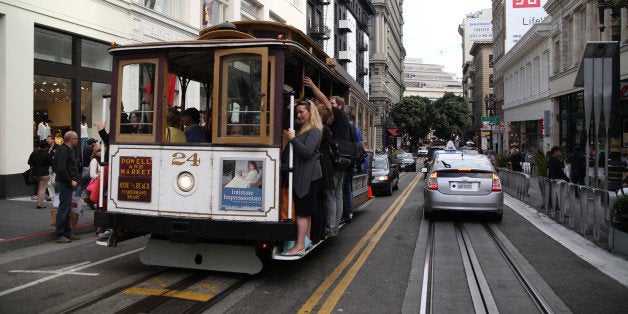
Ever notice how old things are often made new again? Take streetcars, for example.
Back in the day, streetcars were so common that most urban dwellers didn't need to own a car.
But by the 1970s, streetcars had given way to buses in most cities. But now you see them -- or at least the signs of them -- popping up in business districts across America.
Streetcars are enjoying a renaissance as a funky, classic way to ferry "choice riders" -- downtown tourists, people who can afford to drive but opt for transit, office workers running lunchtime errands -- through the historic and commercial areas of our cities.
These new streetcars serve a different purpose than they did in the 20th Century. Most people today can't take a streetcar to work, to the doctor, to church, or to the grocery store. That's not what they're for.
Those of us who work in and depend on public transit know that big changes are needed to get America's transit systems on the right track. But the two questions we need to ask ourselves are always, "change by whom?" and "change for whom?"
From Milwaukee to Kansas City to Sacramento to Detroit, cities are building or proposing streetcar lines to attract high-end developers, condo-dwellers, and shoppers to "trendy" areas where they are most likely to spend money -- perhaps to an "old town," alongside a river, to a historic monument, a stadium, or through the business district in the center of the city. Governments, the commercial interests that stand to profit from their availability, and well-meaning advocates claim streetcars will provide a boost for the local economy.
No Use for Transit Dependent People
But streetcars today are of little, if any, use to those who actually depend on public transit as their primary means of mobility. Unlike light rail, heavy rail, and bus rapid transit, streetcars don't have dedicated lanes to keep them moving free of automobile traffic. And in many cases, they run slower than a standard bus. And unlike a bus, a streetcar can't shift out of its lane to avoid an obstacle, causing more traffic.
Streetcars also divert taxpayer money away from mobility-focused transit that helps working people and into boutique transit loops meant for "choice riders." Meanwhile, bus service that takes people where they really must go gets short shrift, with routes being cut and fares going up. Adding insult to injury, streetcars are usually marketed as "sleek," "premium," "clean" ways for the rising urban class to get around. Rather than investing in and improving transit for everybody, politicians and their corporate backers are intentionally developing parallel transit systems -- one for the well-to-do and one for the rest of us.
Furthermore, new streetcars are often operated by private companies that have a history of mistreating their workers -- paying wages below industry standards, refusing to offer decent benefits, etc. -- and rarely reinvesting the profits they earn in the local area. They donate funds to elected officials who are supposed to represent us, receive millions of our taxpayer dollars in contracts, underpay our neighbors and thus drive down wages across the neighborhood, and then take their profits and spend them somewhere else.
As a result the economic well-being of an entire community is degraded.
"Immoral and Racist"
Big business interests, some of whom have been awarded tax breaks to locate in the city, benefit from this arrangement, as do the city and state governments that collect sales taxes and receive federal grants. The entire scheme is designed to suck as much taxpayer money out of civic treasuries as possible for these boutique streetcars while hanging those who depend on real public transit out to dry.
The big losers, of course, are the seniors and riders with disabilities whose resulting isolation denies the city the gifts they have to offer, and the working poor who, deprived of a way to get to a better job, are thwarted in their efforts to create a brighter future for their families.
That's why one city alderman recently called a Milwaukee streetcar proposal "immoral and racist."
Bright, shiny, new streetcars that convey "choice riders" around town are typically seen as a boon in any urban area. But the truth is that today's streetcars are making transit worse. It's time that municipal governments face up to the theft of public transit resources that the new streetcar lines really are, hold deceitful contractors accountable for selling the streetcar myth, and acknowledge the ultimate toll these investments take on residents who really depend on transit.